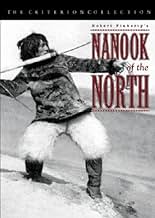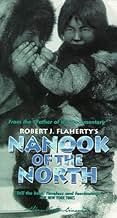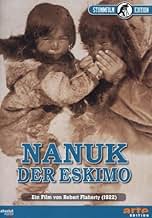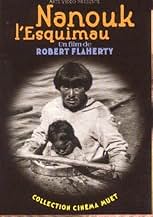IMDb रेटिंग
7.6/10
14 हज़ार
आपकी रेटिंग
अपनी भाषा में प्लॉट जोड़ेंIn this silent predecessor to the modern documentary, film-maker Robert J. Flaherty spends one year following the lives of Nanook and his family, Inuits living in the Arctic Circle.In this silent predecessor to the modern documentary, film-maker Robert J. Flaherty spends one year following the lives of Nanook and his family, Inuits living in the Arctic Circle.In this silent predecessor to the modern documentary, film-maker Robert J. Flaherty spends one year following the lives of Nanook and his family, Inuits living in the Arctic Circle.
- निर्देशक
- लेखक
- स्टार
- पुरस्कार
- कुल 2 जीत
फ़ीचर्ड समीक्षाएं
This is a fascinating documentary from Robert Flaherty, a very prolific director of early documentaries. He follows the adventures of the Eskimo Nanook, and we get to see what life was like for the Eskimo in the early 20th Century as we watch Nanook with his family, hunting for food, and building igloos.
This is really amazing stuff for 1922. It feels like it could have been made long after that. That's probably due to the fact that it relies on real settings and real people. It's not bound by the restrictions of manufactured sets, costumes, etc. of the period. However, though it looks utterly authentic, don't be fooled into thinking that Flaherty gives us a purely realistic snapshot of Eskimo life. He planted the early seeds of reality t.v. with this film, making careful use of editing to create a narrative with all of the melodramatic trappings of any studio picture. Though it's a fascinating film, it's also a reminder that documentary film is just as manipulative as fiction, and that Michael Moore wasn't the first to corner the market on presenting fiction as fact.
Grade: A
This is really amazing stuff for 1922. It feels like it could have been made long after that. That's probably due to the fact that it relies on real settings and real people. It's not bound by the restrictions of manufactured sets, costumes, etc. of the period. However, though it looks utterly authentic, don't be fooled into thinking that Flaherty gives us a purely realistic snapshot of Eskimo life. He planted the early seeds of reality t.v. with this film, making careful use of editing to create a narrative with all of the melodramatic trappings of any studio picture. Though it's a fascinating film, it's also a reminder that documentary film is just as manipulative as fiction, and that Michael Moore wasn't the first to corner the market on presenting fiction as fact.
Grade: A
Robert J. Flaherty's `Nanook Of The North' may be the first film about man's relationship with nature. Flaherty helps establish man's successful adaptation to his environment by filming extraordinary hunting and fishing scenes consisting largely of medium shots. The few close-ups of the Inuit generally portray the successful hunters smiling as they eat their kill. Flaherty contrasts these moments with sequences communicating the Inuit's struggles with the natural world. Here, he uses long shots: Nanook and his family become tiny black specks barely visible in the large, white frame. In the foreground the viewer sees bitter gusts of wind ruling over the desolate landscape. Flaherty's technique is simple but very effective. Not only does he depict man as a mere part of his environment, but he emphasizes how powerless man may feel amid the cold indifference of nature. At the same time, the hunting and feast sequences establish Nanook as a smart, tough survivor, a surprising victor over nature's harsh elements. In this way, Flaherty makes Nanook into a heroic figure.
Rating: 9.5
Rating: 9.5
"Nanook of the North" is a film that shows the life of Nanook and his family back in 1920 in the frozen North of Canada. Most of the film shows Nanook hunting and fishing--most other activities are not seen.
I'll be honest about this one--"Nanook of the North" is NOT a film for everyone. It's a semi-documentary with very limited appeal. I am not surprised that it was released as part of the ultra-artsy Criterion Collection. After all, how many people want to see a film about the life of the Inuit in Northern Canada?! However, for fans of documentaries, it's well worth seeing, as it's one of the very early ones. But you might have noticed that I called it a 'semi-documentary'--a term that should be used more often. That's because a true documentary shows what is--not a fictional account of what is. And, while what you see is typical in some ways about the Inuit, it was NOT typical of the Inuit in 1920. These folks no longer hunted and lived like they did in this film due to their contact with the outside world. And so, what you see is more like the Inuit BEFORE they made contact with the modern world. Apparently, in 1920, these folks were using guns and other modern bits of technology that are not shown in the film. Additionally, the filmmaker staged much of the film. For example, Nannok's wife in the film really isn't his wife! But with all these problems, is the film worthless? Certainly not!! It's fascinating from start to finish and is more like a recreation of ancient Inuit life--and in this sense, it's an invaluable record--but one most people probably don't care much about today--mostly it's a film for academicians and film historians.
I'll be honest about this one--"Nanook of the North" is NOT a film for everyone. It's a semi-documentary with very limited appeal. I am not surprised that it was released as part of the ultra-artsy Criterion Collection. After all, how many people want to see a film about the life of the Inuit in Northern Canada?! However, for fans of documentaries, it's well worth seeing, as it's one of the very early ones. But you might have noticed that I called it a 'semi-documentary'--a term that should be used more often. That's because a true documentary shows what is--not a fictional account of what is. And, while what you see is typical in some ways about the Inuit, it was NOT typical of the Inuit in 1920. These folks no longer hunted and lived like they did in this film due to their contact with the outside world. And so, what you see is more like the Inuit BEFORE they made contact with the modern world. Apparently, in 1920, these folks were using guns and other modern bits of technology that are not shown in the film. Additionally, the filmmaker staged much of the film. For example, Nannok's wife in the film really isn't his wife! But with all these problems, is the film worthless? Certainly not!! It's fascinating from start to finish and is more like a recreation of ancient Inuit life--and in this sense, it's an invaluable record--but one most people probably don't care much about today--mostly it's a film for academicians and film historians.
Explorer Robert J. Flaherty spent the majority of 1914 and 1915 along the Hudson Bay, doing research and exploring for a Canadian railway company. Being a keen photographer and potential film-maker, he took a camera along with him. He shot 30,000 feet of film, of the native Eskimo tribes and their alien, hunter-gatherer lifestyle. The test footage was met with universal excitement, only Flaherty dropped a cigarette on the highly-flammable nitrate film-stock whilst editing, and lost it all. He would return, only this time with the sole intent on making a narrative- driven documentary, about one specific family of Eskimos, and their highly-charismatic leader Nanook, a legendary hunter.
Though it is now widely heralded as a masterpiece, and the film that gave birth to the documentary genre, the film is often criticised for its obviously staged dramatic scenes, and truth-manipulation in the search for a coherent narrative and to inject the film with an air of excitement and wonder. Personally, I have no problem with this approach, after all, one of my favourite directors Werner Herzog frequently does this in his documentary films to create a sort of artistic truth, opposed to the point-the-camera approach of cinema verite. In the modern age, we are treated to high-definition, sweeping footage of some of the most exotic and hostile corners of the planet, so it's a marvel to see where it all started, and Flaherty, faced with early, clunky film equipment and relatively little experience of film-making, created a magical documentary for an audience that, back then, knew little about the world outside their own country.
Amongst the many set-pieces we are treated to, the greatest (and much- celebrated) is the building of the igloo. We watch Nanook build it with skilled precision, slab by slab, and even incorporate a window feature, in order to give the igloo some warmth, and a chunk of ice by the side of it to divert the sun's rays. With many Eskimos now adopting Western aspects into their livelihood, the film is definitely a window into the past (the Eskimos had in fact already done this, and even wore Western clothes, but Flaherty persuaded them to revert back in order to give the film more of a sense of wonder). For a film-maker who had only taken a three-week course in cinematography prior to Nanook, the film is rich with beautiful imagery. The scene that watches the family trudge into the distance as the mist blows over the snowy surface like fleeing ghosts, gives the film a gorgeous, eerie quality. If you can forgive the film's manipulations, then this is still one of the greatest documentaries features ever produced, and Nanook (real name Allakariallak) proves to be a charming protagonist.
www.the-wrath-of-blog.blogspot.com
Though it is now widely heralded as a masterpiece, and the film that gave birth to the documentary genre, the film is often criticised for its obviously staged dramatic scenes, and truth-manipulation in the search for a coherent narrative and to inject the film with an air of excitement and wonder. Personally, I have no problem with this approach, after all, one of my favourite directors Werner Herzog frequently does this in his documentary films to create a sort of artistic truth, opposed to the point-the-camera approach of cinema verite. In the modern age, we are treated to high-definition, sweeping footage of some of the most exotic and hostile corners of the planet, so it's a marvel to see where it all started, and Flaherty, faced with early, clunky film equipment and relatively little experience of film-making, created a magical documentary for an audience that, back then, knew little about the world outside their own country.
Amongst the many set-pieces we are treated to, the greatest (and much- celebrated) is the building of the igloo. We watch Nanook build it with skilled precision, slab by slab, and even incorporate a window feature, in order to give the igloo some warmth, and a chunk of ice by the side of it to divert the sun's rays. With many Eskimos now adopting Western aspects into their livelihood, the film is definitely a window into the past (the Eskimos had in fact already done this, and even wore Western clothes, but Flaherty persuaded them to revert back in order to give the film more of a sense of wonder). For a film-maker who had only taken a three-week course in cinematography prior to Nanook, the film is rich with beautiful imagery. The scene that watches the family trudge into the distance as the mist blows over the snowy surface like fleeing ghosts, gives the film a gorgeous, eerie quality. If you can forgive the film's manipulations, then this is still one of the greatest documentaries features ever produced, and Nanook (real name Allakariallak) proves to be a charming protagonist.
www.the-wrath-of-blog.blogspot.com
From a historical standpoint, this film really established the role of the documentary. While most of the scenes were set up and what-not, this is still an interesting tales to ponder. The whole idea of this film was to display the world of the Inuit, in all of its harshness. The cinematography was excellent, and the shot at the end is both haunting and breathless.
क्या आपको पता है
- ट्रिवियाThe claim that Allakariallak died of starvation in 1922, months after the film was completed, is untrue; he did not starve but likely succumbed to tuberculosis.
- भाव
Title Card: The shrill piping of the wind, the rasp and hiss of driving snow, the mournful wolf howls of Nanook's master dog typify the melancholy spirit of the North.
- क्रेज़ी क्रेडिटA story of life and love in the actual arctic.
- इसके अलावा अन्य वर्जनRemastered with image enhancement, speed correction and a new score in 1998
- कनेक्शनEdited into Saumialuk. Le grand gaucher (1990)
टॉप पसंद
रेटिंग देने के लिए साइन-इन करें और वैयक्तिकृत सुझावों के लिए वॉचलिस्ट करें
- How long is Nanook of the North?Alexa द्वारा संचालित
विवरण
बॉक्स ऑफ़िस
- बजट
- $53,000(अनुमानित)
- चलने की अवधि1 घंटा 18 मिनट
- ध्वनि मिश्रण
- पक्ष अनुपात
- 1.33 : 1
इस पेज में योगदान दें
किसी बदलाव का सुझाव दें या अनुपलब्ध कॉन्टेंट जोड़ें


























